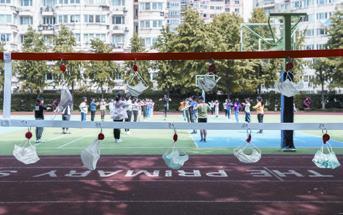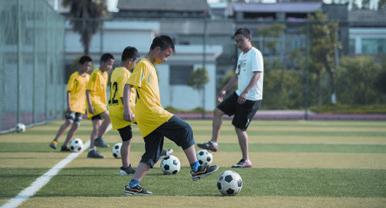Fit Youth,Strong Nation
By Li Qing
As a former athlete, Wen Yang is a fi tness fanatic. Following the principle of catchem young, the Beijing resident, who now runs a garment business in the capital, is particular about his sons physical exercises. Seven years ago, when the boy became a primary school fi rst grader, Wen felt the physical training at the school was insufficient. So he, with the support of other parents, set up a football club where youngsters can continue physical exercises after class.
He thinks although children today have more entertainment means and a better quality of life, still they are not as happy as his generation, who had a lot of time to do things outdoors with friends. “The leisure activities of todays youngsters tend to be more sedentary and electronic device-based, putting health at risk,” Wen told Beijing Review.
In recent years, myopia, obesity, diabetes and other problems have become common among teenagers. Wen suggests increasing physical activities as a remedy. Having worked in the sports sector for many years, he knows the signifi cance of encouraging young people to exercise to improve both their physical and mental fi tness.
Alarming trend
China today faces the issue of rising bad health among teens with the primary indicators of physical health declining for over 20 consecutive years and 33 percent of children and adolescents facing health risks in various degrees, according to Cheng Hong, a member of the National Committee of the Chinese Peoples Political Consultative Conference (CPPCC), the top political advisory body. Cheng broached the subject during this years Two Sessions, the annual meetings of the national legislature and the advisory body.She said that the outbreak of the novel coronavirus disease has given people a lesson in health education, highlighting the importance of physical fi tness and a strong immune system. “It is essential to take this opportunity to raise their health awareness, especially for teenagers,” she added.
She also suggested building a national platform with big data to monitor childrens physical fitness while enhancing physical education in schools.
“Physical decline is a global trend. It started in developed countries in the 1960s and in China in the 1990s,” Zhong Bingshu, head of Capital University of Physical Education and Sports in Beijing, told Beijing Review. But despite its late entry in China, the trend has been growing faster here than the world average. Today, changes in lifestyle and diet have also caused changes in peoples health. Besides, the academic burden on students is reducing their physical activity time. Physical activities and a scientifi c way of living are necessary to improve teen health, Zhong said.
The government has issued guidelines and organized activities to grow peoples awareness. For instance, in August 2019, the State Council, Chinas cabinet, released an outline to develop China into a strong sports country by 2050. The document called for improving physical education in schools and making it a part of the government performance assessment system. It also suggested building a social physical activity network, like winter and summer camps, where teenagers could develop skills in at least two sports.
Sports education
Wen is delighted to see how football can change youngsters. For instance, he has seen spoilt students become independent after attending football training. They learn to solve problems on their own or through cooperation and analyze what should be done for further progress.“Through football games, teenagers can understand that competition means putting all your effort to achieve your goal. Also, they teach young people to respect their competitors and the rules. That is the spirit of sports,” he said.
Since most of todays Chinese teenagers are the only child in their families, they need to learn how to work together with others, as well as strengthen interpersonal communication, Zhong said. “Also, their experience during the games can encourage them to overcome setbacks in life,” he said.
The Chinese Government has been encouraging the promotion of football for many years. Zhong feels the government should provide subsidies to introduce quality sports institutions, such as football schools, in communities to provide physical education.
Exercise can also help relieve young peoples academic pressure, according to Li Fuyi, a career planning coach at Tsinghua University. People who exercise regularly are found to be less likely to suffer from depression, Li told Beijing Review.
During the Two Sessions, over 100 CPPCC members from Fujian Province, southeast China, made a joint proposal to establish more diversifi ed evaluation standards for the education system and bolster physical fi tness.
“The tendency of employers to have a strong preference for individuals with diplomas from key universities must be reversed, and the level of fitness must be included during their assessment of candidates,” Wu Zhiming, head of the Fujian branch of the China Vocational Education Association and one of the advisers, told China Daily.
Wu proposed including physical exercises in senior high school and college entrance exams to ensure they carry the same weight as academic subjects.
However, Zhong begs to differ. He thinks mandatory exams will lead to new problems in the popularization of physical education and sports. For example, schools may then teach only the content for the tests, making the curriculum rigid. It would then have a detrimental effect on students interest in exercise, which is the purpose of physical education on campus.
“For instance, in Shanghai, students can choose specif ic sports from junior school. This model can be borrowed by other education administrations,” Zhong said. He suggested students could follow one or two sports continuously, which could become their hobbies or skills for the rest of their life. He also felt schools should organize contests because teenagers can get a sense of achievement through them.
Community approach
With the increasing emphasis on physical education, there is a rising demand for qualifi ed coaches. That is a major challenge Wen is facing. He wants to recruit coaches with high professional and individual qualities for his football club but it is hard to fi nd such people.According to Li, two major sources of teachers are retired athletes and physical education graduates. They have the advantage of practical experience and theoretical knowledge respectively. However, they may have shortcomings in other aspects. Therefore, training programs should be designed for potential coaches. Still, improving youngsters physical fitness needs the participation of parents and society as well, not just schools, because the key time for activities is after class, Zhong said.
This year, Yang Yang, Chinas first Winter Olympic gold medalist and a CPPCC member, suggested developing community sports in her proposal. Today, most of the public sports facilities in communities are designed for adults, with few suitable for young people, she told The Beijing News. “But many children, especially at the preschool phase, find their interest through their daily life,” she said.
Sports facilities can be varied according to local conditions, Zhong said. A small public area is suffi cient for children to play football. “From this perspective, there is huge potential in our communities to build public sports facilities for teenagers,” he said.

